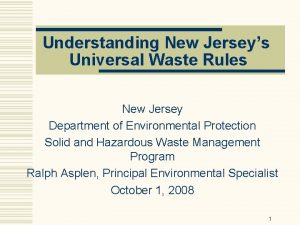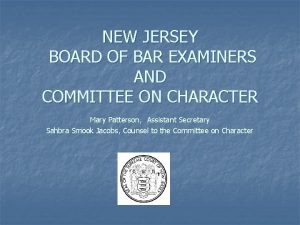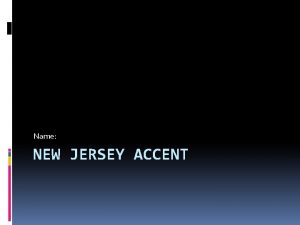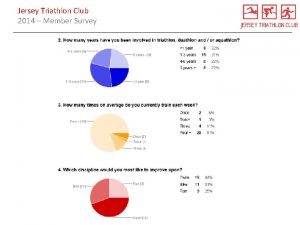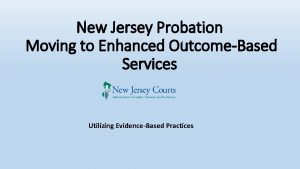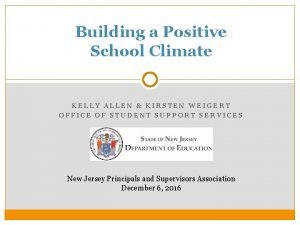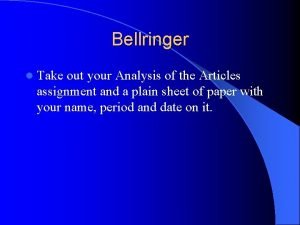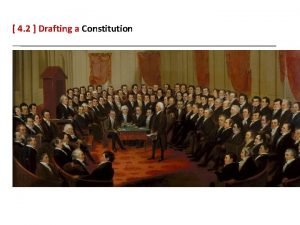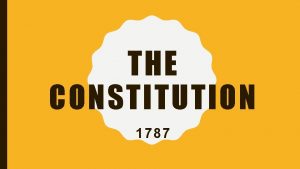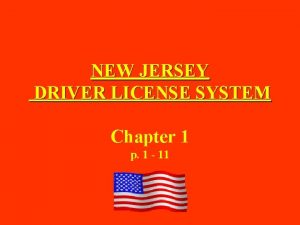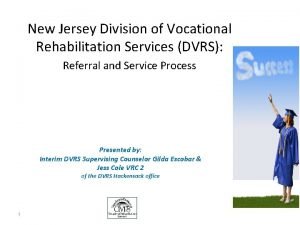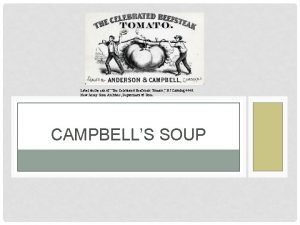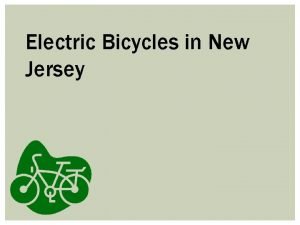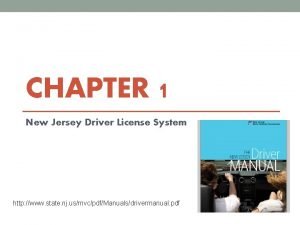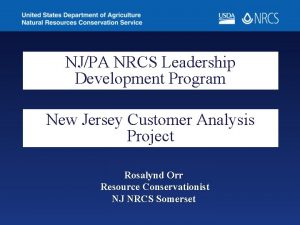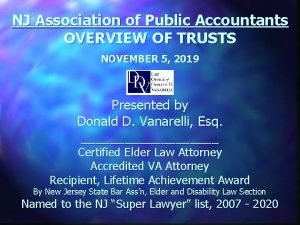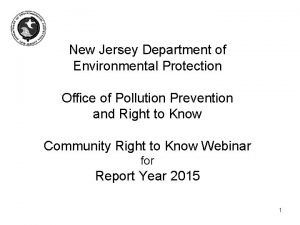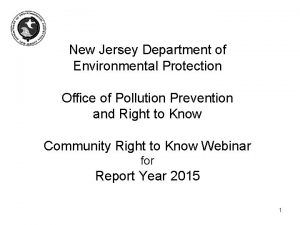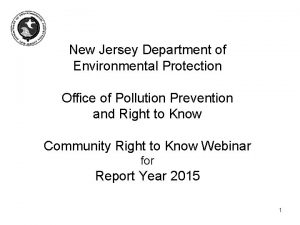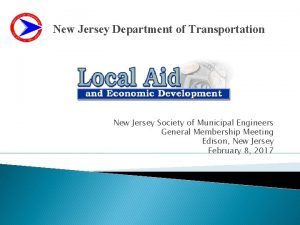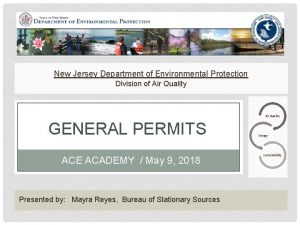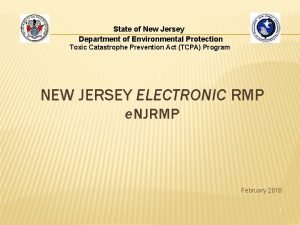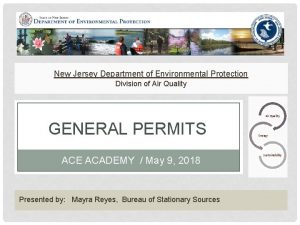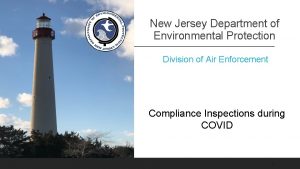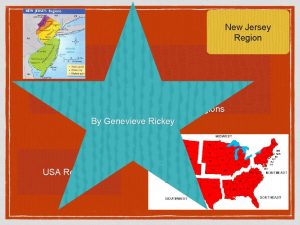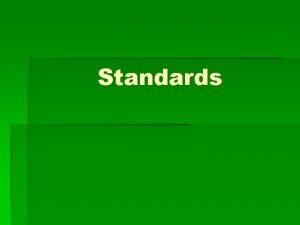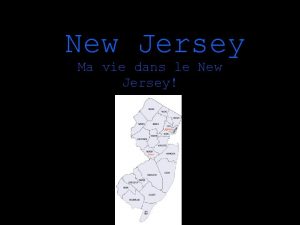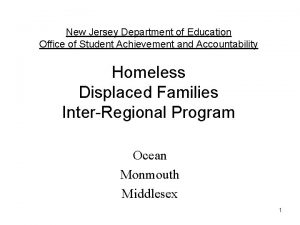New Jersey Department of Environmental Protection Office of




































- Slides: 36

New Jersey Department of Environmental Protection Office of Pollution Prevention and Right to Know Community Right to Know Webinar

Purpose of Community Right to Know (CRTK) • Increase community awareness of chemical hazards • Support and focus state/local planning activities • Support chemical accident and pollution prevention initiatives

SURVEYS DUE MARCH 1 ALL SURVEYS MUST BE SUBMITTED ELECTRONICALLY

Who Must Complete a CRTK Survey New Jersey • Employer as defined by the New Jersey Worker and Community Right to Know Act – Based on the North American Industry Classification System (NAICS) Codes Access the NAICS Codes at: http: //www. nj. gov/dep/opppc/figdoc. htm Federal • Emergency Planning and Community Right to Know Act (EPCRA) – Any facility, regardless of industry sector, if hazardous substances are present above threshold quantities

What Must Be Reported New Jersey • Hazardous substances on the NJ CRTK Environmental Hazardous Substance (EHS) List – Typically, 500 pound threshold Access the NJ List at: http: //www. nj. gov/dep/opppc/figdoc. htm Federal • Any hazardous substance or product for which a Material Safety Data Sheet (MSDS) is required per the OSHA Hazard Communication Standard – Typically 10, 000 pound threshold New Jersey and Federal • Extremely Hazardous Substances (EPCRA Section 302) – Contained in the NJ EHS List – Designated with an asterisk (*) – Threshold Planning Quantity (TPQ)

Community Right to Know Facility Reporting Exemptions • Facilities that previously reported as a Non-User or User Below Threshold of NJ CRTK Environmental Hazardous Substances (EHS’s) • Employers within an Exempt NAICS Subcategory – 423830 Industrial Machinery and Equipment Merchant Wholesalers – Except facilities engaged in sales of industrial machinery and equipment (merchant – wholesalers) • Unstaffed Sites (cell towers, well stations, switching boxes, etc. ) unless EPCRA reporting thresholds are met or exceeded • Employers if all locations in NJ perform Administrative functions only • Can only be Exempt after initial notification to NJDEP

Community Right to Know Facility Reporting Exemptions If you believe you fit into one of these Reporting Exemptions, and you have not received prior confirmation from NJDEP that you are Exempt, you can go to: http: //www. nj. gov/dep/opppc/figdoc. htm and complete and submit a CRTK Reporting Exemption Form. You do not have to set up an online account or complete a CRTK Survey.


You Must complete all fields and you Must indicate which exemption applies or the from will be returned to you.

Community Right to Know Facility Reporting Exemptions • Must notify NJDEP if change in status • NJDEP conducts periodic, random, inspections to verify status • For Non-Users, Users Below Threshold, and Unstaffed Sites, notification must have been made on or after January 1, 2005 – First reporting period after the CRTK Rules were revised to expand the exemption list.

Community Right to Know EHS Reporting Exemptions • EHS’s present, in aggregate, below threshold quantities • EHS’s at facilities, or portions of facilities, used primarily for research and development (R&D) – Must obtain a CRTK R&D Laboratory Exemption from NJDEP – http: //www. nj. gov/dep/opppc/crtk/rdexap. pdf • EHS’s that are an integral part of the facility structure or furnishings • EHS’s that are, or are contained, in personal property for the personal use of employees

Community Right to Know EHS Reporting Exemptions • EHS’s present as a solid in any manufactured item formed into a specific shape or design during manufacture to the extent that exposure to any EHS does not occur under normal conditions of use. – Does not include Saran, PVC and Lopac • EHS’s comprising 1% or less of a mixture, or 0. 1% if the EHS is carcinogenic as defined at 29 CFR 1910. 1200 (d)4 of the OSHA Hazard Communications Regulation • EHS’s contained in ammunition on the person of security personnel

Special Reporting Requirements Multiple Occurrences of EHS • May be grouped as one entry if: – Same container type – Same storage conditions • Solid/liquid/gas • If any of the above criteria differ, EHS must be listed separately • All hazards must be listed

Special Reporting Requirements • Diesel fuel, #2 heating oil, gasoline, kerosene, petroleum oil and waste oil – Reportable if present in quantities of 10, 000 pounds or greater • Can use 7 pounds/gallon to convert from gallons to pounds – A quantity of 1, 429 gallons or greater would exceed the 10, 000 pound threshold – Do not need to identify EHS constituents • Alternative Fuel – Reportable if contains more than 10% ethanol and present in quantities of 10, 000 pounds or greater

Special Reporting Requirements • Wastes – Reportable if EHS present elsewhere at the facility at or above the reporting threshold • Do not include quantities of waste in threshold determinations – Combine reporting of EHS in wastes and non-wastes to determine inventory if stored in the same container type – If the waste contains a mixture of EHS’s report it as “Haz Waste, N. O. S. (only if EHS reported)”

Special Reporting Requirements • Quality Assurance Labs – Small samples of EHS’s that are present elsewhere at or above reporting threshold – Group and report as one entry • “Substance Samples (only if EHS is reported)” • If stored in same contained, enter container code • If stored in multiple containers, select “Other” from dropdown menu and enter “OT” in Container Description box • Use substance number 3628

New Reporting Requirements Effective Reporting Year 2013 • USEPA finalized changes to the federal Emergency Planning and Community Right to Know Act (EPCRA) in July 2012. • Changes effective January 1, 2014 (For the Survey due March 1, 2014) • Changes have been incorporated into the electronic reporting forms • Applicable to any facility that is subject to federal EPCRA reporting requirements only, or any facility that reported as least one substance not on the NJ CRTK EHS list for RY 2012.

New EPCRA Reporting Requirements Effective Reporting Year 2013 • Additional facility info fields – – – Latitude and longitude Maximum number of occupants at any one time Manned or unmanned TRI Facility ID RMP Facility ID Facility Section 302 Emergency Coordinator • Additional Yes/No Questions – Subject to emergency planning under Section 302 of EPCRA? – Subject to chemical accident prevention under Section 112 r of the Clean Air Act (40 CFR part 68, Risk Management Program)? • Optional Information – Parent Company name, address and Dun and Bradstreet Number

New EPCRA Reporting Requirements Effective Reporting Year 2013 • Additional inventory info – Separate reporting for Pure Substances and Mixtures – If reporting a mixture, must report any EPCRA Section 302 Extremely Hazardous Substance components present at or above threshold planning quantity (TPQ) – Must aggregate all instances of the 302 substance to determine if the TPQ has been meet or exceeded • Substance name • Chemical Abstract Service (CAS) number • Maximum daily inventory quantity • Only report a substance as a mixture if the substance itself is a mixture, not if the substance is contained in a mixture – IE. Sulfuric acid in a battery will be reported as a Pure substance even though it is contained in a mixture – Any substance on the NJ CRTK EHS list will automatically be reported as a Pure substance • Pressure and temperature description will appear on the printed survey instead of the codes




Please note that you must click Add Chemicals before leaving this page.



Threshold Determinations • Determine if EHS’s present at any time during the reporting year • All occurrences of an EHS must be aggregated to determine if the threshold has been exceeded • If threshold exceeded, all occurrences of EHS must be reported • Solids – Only the quantity of an EHS in fume or dust from a solid piece of material being modified needs to be calculated for threshold determinations – Do not include the weight of the entire material being modified

Threshold Determinations Trenton Manufacturing Company 401 East State Street, Trenton, NJ 08625 CRTK Facility ID 00000057927 Latitude – 40. 259090 Longitude - -74. 815828 NAICS Code 325212 - SYNTHETIC RUBBER MANUFACTURING Federal Toxic Release Inventory (TRI) ID# 12345 TRNTMFG 401 USEPA RMP ID# 12345678900

Threshold Determination Trenton Manufacturing Company Facility has 200 gallons of degreasing solvent. Material Safety Data Sheet (MSDS) shows it contains 40% benzene, 20% toluene and 10% xylene Convert gallons to pounds using density of solvent from MSDS 200 gal X 8 lbs/gal = 1, 600 pounds of solvent – 1, 600 X 0. 40 = 640 pounds of benzene – 1, 600 X 0. 20 = 320 pounds of toluene – 1, 600 X 0. 10 = 160 pounds of xylene

Threshold Determination Trenton Manufacturing Company Facility has 100 gallons of paint and 150 gallons of solvent. MSDS shows the paint contains 15% toluene and the solvent 20% toluene Convert gallons to pounds using density of solvent from MSDS 100 gal X 8 lbs/gal = 800 pounds of paint – 800 pounds X 0. 15 = 120 pounds of toluene in the paint 150 gals X 8 lbs/gal = 1200 pounds of solvent – 1200 X 0. 20 = 240 pounds of toluene in the solvent Aggregate the quantities of toluene – 120 pounds + 240 pounds = 360 pounds of toluene

Threshold Determination Trenton Manufacturing Company Facility has 2, 000 cubic feet of methane in liquid form and 1, 000 cubic feet of chlorine as a gas. Convert cubic feet to pounds* • Methane – 2000 ft 3 X 26. 3 pounds/ft 3 = 52, 000 pounds of methane • Chlorine – 1, 000 ft/3 X 0. 200 pounds/ft 3 = 200 pounds of chlorine * Conversion table found in CRTK Guidance http: //www. nj. gov/dep/opppc/crtk/figdoc. htm Document –

Threshold Determination Trenton Manufacturing Company Facility is cutting a 5, 000 pound piece of steel that contains 20% chromium. They estimate that approximately 30% of the steel is being generated as dust from the cutting operation. – 5, 000 pounds X 0. 20 = 1, 000 pounds of chromium – 1, 000 pounds X 0. 30 = 300 pounds of chromium in the dust

Threshold Determination Trenton Manufacturing Company Facility has 20, 000 pounds of a product called TRXYZ Per the OSHA Hazard Communication Standard required to have an MSDS Per the MSDS, this product contains 30% acrolein, 40% tire rubber and 30% banana oil 20, 000 pounds x. 30 = 6, 000 pounds acrolein 20, 000 pounds x. 40 = 8, 000 pounds tire rubber 20, 000 pounds x. 30 = 6, 000 pounds banana oil

Threshold Determination Trenton Manufacturing Company Benzene = 640 Pounds Toluene = 320 pounds (degreasing solvent) + 360 Pounds (paint and solvent) = 680 pounds toluene Xylene = 160 pounds Methane = 52, 000 pounds Chlorine = 200 pounds Chromium = 300 pounds Product TRXYZ = 20, 000 pounds 6, 000 pounds acrolein 8, 000 pounds tire rubber 6, 000 pounds banana oil Benzene, toluene and methane exceed the 500 pound reporting threshold, chlorine exceeds the 100 pound TPQ and Product TRXYZ exceeds the EPCRA 10, 000 pound reporting threshold and contains one EPCRA Section 302 substance. These must all be reported.

Distribution of the CRTK Survey ü Original to NJDEP (Electronically) ü Local Fire Department (Printed Copy) ü Local Police Department (Printed Copy) ü County Lead Agency (Printed Copy) ü Local Emergency Planning Committee (Printed Copy) ü Employer’s file copy (Printed Copy)

Office of Pollution Prevention and Right to Know 609 -777 -0518 609 -292 -6714 http: //www. nj. gov/dep/opppc

Questions?
 Nyc department of environmental protection
Nyc department of environmental protection New york, new jersey, pennsylvania, and delaware
New york, new jersey, pennsylvania, and delaware Universal waste examples
Universal waste examples New jersey space grant consortium
New jersey space grant consortium The new jersey driver manual
The new jersey driver manual Piedmont region nj
Piedmont region nj New jersey center for teaching and learning
New jersey center for teaching and learning How many total squares are there
How many total squares are there New jersey bar laptop program
New jersey bar laptop program Jersey accent video
Jersey accent video Jersey tri club
Jersey tri club New jersey dyslexia handbook
New jersey dyslexia handbook New jersey plan vs virginia plan
New jersey plan vs virginia plan New jersey grants & scholarships 2020-21
New jersey grants & scholarships 2020-21 Getting a drivers license illegally may result in
Getting a drivers license illegally may result in New jersey social emotional learning standards
New jersey social emotional learning standards New jersey courts
New jersey courts New jersey institute for continuing legal education
New jersey institute for continuing legal education Www.njctl.org answer key
Www.njctl.org answer key Italiani in new jersey
Italiani in new jersey Kelly allen new jersey
Kelly allen new jersey Virginia plan and new jersey plan venn diagram
Virginia plan and new jersey plan venn diagram The new jersey plan
The new jersey plan Viva new jersey vocabulary words
Viva new jersey vocabulary words Viva new jersey vocabulary
Viva new jersey vocabulary New jersey absolute location
New jersey absolute location New jersey plan
New jersey plan Sea lice new jersey
Sea lice new jersey Chapter 1 nj driver license system
Chapter 1 nj driver license system Division of vocational rehabilitation
Division of vocational rehabilitation New jersey beefsteak tomatoes
New jersey beefsteak tomatoes Nj ebike laws
Nj ebike laws New jersey science teachers association
New jersey science teachers association Chapter 1 the new jersey driver license system answers
Chapter 1 the new jersey driver license system answers Flood dream ocean city new jersey 1971
Flood dream ocean city new jersey 1971 Leadership development new jersey
Leadership development new jersey New jersey association of public accountants
New jersey association of public accountants


